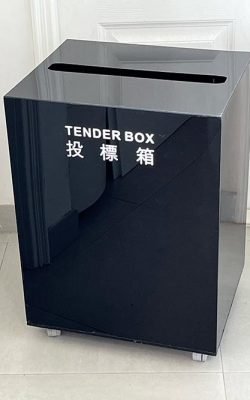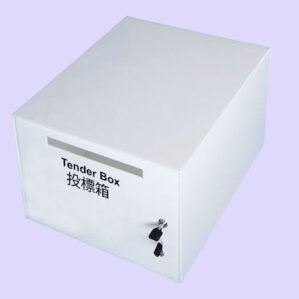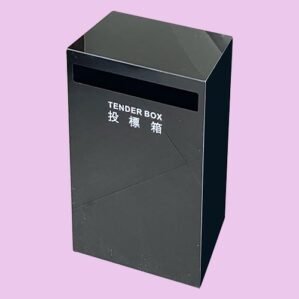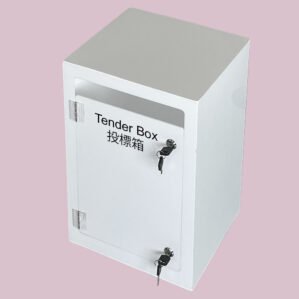Tender Box | how to select
Choosing the right tender box is a critical decision for organizations that regularly manage procurement processes, bid submissions, and competitive tenders. A tender box is not just a physical or digital receptacle; it represents the integrity, transparency, and efficiency of the entire tendering process. The wrong choice can lead to security risks, compliance issues, and operational inefficiencies, while the right choice can streamline processes, safeguard sensitive information, and ensure fairness.
This article explores the essential factors to consider when selecting a tender box, helping businesses make informed decisions that align with their procurement objectives.
1. Security and Confidentiality
The most important factor in choosing a tender box is security. Tender submissions often contain confidential financial proposals, proprietary methodologies, and sensitive organizational information. Whether you choose a physical or digital tender box, it must guarantee confidentiality.
Physical tender box: Should be tamper-proof, lockable, and ideally placed in a monitored location. Multiple security layers such as dual-key locks or restricted access areas add extra protection.
Electronic tender box: Must include advanced encryption, secure user authentication, and audit trails. It should prevent unauthorized access and ensure only designated procurement officers can view submissions after the closing deadline.
SEO keywords: tender box security, secure tender submissions, confidential procurement process
2. Compliance With Regulations
Procurement processes are often governed by strict rules and regulations, especially in government and public sector projects. The tender box you select should fully support compliance requirements.
Time-stamping: Every submission must be recorded with a date and time to avoid disputes.
Access control: Compliance standards often require that no one can access submissions before the official opening.
Audit capability: A reliable tender box should produce auditable records for review and oversight.
Ensuring regulatory compliance protects organizations from legal risks and strengthens trust with bidders.
SEO keywords: tender compliance, procurement regulations, audit trail tender box
3. Capacity and Scalability
Organizations differ in the volume of tenders they manage. Some may handle a handful of bids monthly, while others may receive thousands annually. Your tender box should be selected based on both current needs and potential growth.
Physical tender box: Choose a size large enough to accommodate expected submissions without overcrowding.
Digital tender box: Must handle multiple simultaneous uploads, support large file formats (drawings, PDFs, spreadsheets), and scale with organizational growth.
Scalability ensures the solution remains effective as your procurement activities expand.
SEO keywords: scalable tender box, tender submission capacity, digital procurement solutions
4. Ease of Use
The tender process involves multiple stakeholders: suppliers, procurement staff, auditors, and management. A tender box should therefore be user-friendly.
For suppliers: The submission process must be straightforward, with clear instructions and minimal technical barriers.
For evaluators: The system should enable easy retrieval, organization, and review of tenders.
Training requirements: Ideally, the solution should require little to no extensive training.
A complicated system increases the risk of submission errors and delays, which can undermine the fairness of the process.
SEO keywords: user-friendly tender box, easy tender submission, supplier-friendly procurement
5. Accessibility and Availability
Accessibility is another critical consideration. Suppliers should have convenient access to submit tenders, and procurement staff must be able to manage the process efficiently.
Physical accessibility: If using a physical tender box, its location must be secure yet convenient for suppliers. Extended access hours may also be necessary.
Online accessibility: Digital tender boxes must be accessible 24/7, allowing global suppliers to participate across different time zones. Compatibility with various devices (desktop, tablet, mobile) is essential.
Greater accessibility promotes inclusivity and encourages more competitive participation.
SEO keywords: tender box accessibility, online tender submissions, global procurement solutions
6. Reliability and Technical Support
Technical failures can jeopardize the integrity of the tendering process. A tender box must be reliable and supported by responsive technical assistance.
Physical systems: Should be durable and resistant to tampering or environmental damage.
Electronic systems: Must have guaranteed uptime, regular backups, and disaster recovery protocols. Vendors should provide 24/7 technical support, especially during critical submission deadlines.
Reliability builds confidence among suppliers and minimizes the risk of disputes.
SEO keywords: reliable tender box, technical support procurement, secure e-tender systems
7. Cost and Value for Money
Cost is always a practical consideration, but the cheapest option may not always provide the best value. Decision-makers should weigh cost against functionality, reliability, and compliance.
Physical tender box costs: Relatively low upfront, but limited in functionality.
Digital tender box costs: Subscription-based or license fees, but they provide advanced security, scalability, and automation.
Evaluating total cost of ownership, including maintenance, training, and upgrades, ensures the chosen solution delivers long-term value.
SEO keywords: tender box cost, affordable tender solutions, value for money procurement
8. Integration With Procurement Systems
In today’s digital procurement environment, integration is key. Many organizations use procurement management systems, ERP platforms, or document management tools.
A modern electronic tender box should:
Integrate seamlessly with existing procurement systems.
Support automated workflows such as notifications, reminders, and submission confirmations.
Enable reporting and analytics for better decision-making.
Integration reduces duplication, saves time, and ensures consistency across procurement functions.
SEO keywords: integrated tender box, procurement software integration, automated tender systems
9. Transparency and Fairness
A well-chosen tender box fosters transparency, ensuring all bidders are treated equally. This is vital for maintaining organizational reputation and supplier trust.
Equal opportunity: All suppliers should have the same access to submission methods.
Deadline enforcement: The system must lock out late submissions automatically.
Clear audit trail: Transparency in how tenders are received and managed strengthens fairness.
A transparent system enhances credibility and encourages wider participation in future tenders.
SEO keywords: transparent tender process, fair procurement practices, audit-ready tender system
10. Future-Proofing and Innovation
Technology is evolving rapidly, and procurement processes are becoming more digitized. When choosing a tender box, consider future-proofing your investment.
Cloud-based solutions: Offer scalability, mobility, and reduced infrastructure costs.
Artificial intelligence (AI): Some advanced tender systems now include AI tools for risk analysis and supplier evaluation.
Sustainability: Moving to electronic tender boxes reduces paper use and aligns with green procurement policies.
Choosing an innovative system ensures your procurement process remains efficient and competitive in the long term.
SEO keywords: future-proof tender box, digital procurement innovation, sustainable tender solutions
Conclusion
Selecting the right tender box requires a balance of security, compliance, accessibility, and cost-effectiveness. Whether you choose a physical or digital option, the ultimate goal is to protect sensitive information, ensure fairness, and streamline procurement workflows.
By carefully evaluating factors such as security, compliance, scalability, ease of use, and integration, organizations can choose a tender box that supports transparent, reliable, and future-ready procurement processes.
A well-considered tender box is more than just a receptacle—it is a cornerstone of integrity and efficiency in tender management.






